#ussr cosmos
Text
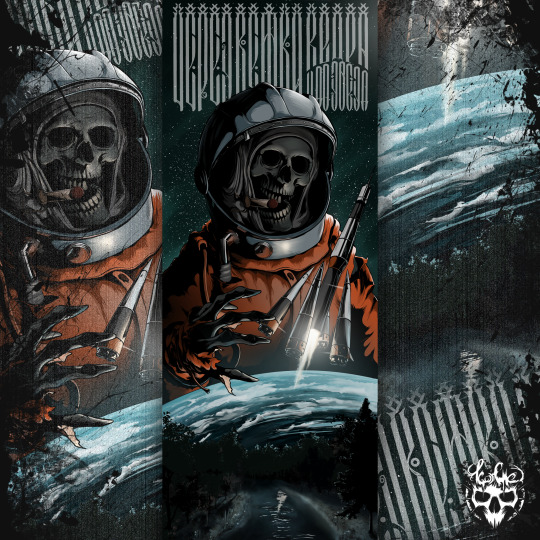
Через ветки кедра и до звезд!
0 notes
Text

"Be proud, Soviet man, you have opened the path to the stars from the Earth!"
Soviet Union
c. 1960
#propaganda#poster#vintage#imperialism#capitalism#communism#socialism#ussr#soviet#union#russia#space#cosmos#cosmonaut
249 notes
·
View notes
Text
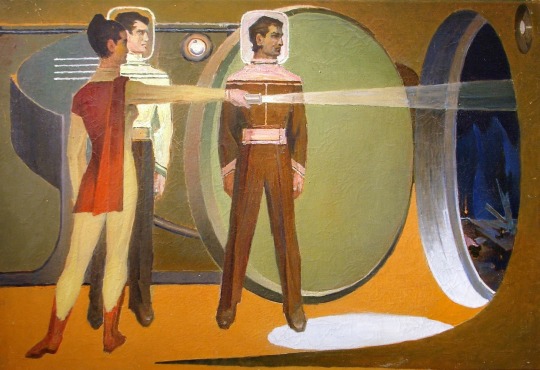
Gennady Golobokov "At the goal". The 1970s
Геннадий Голобоков "У цели". 1970-е
#ussr#soviet#soviet union#soviet art#painting#creepy#русский tumblr#русский тамблер#русский блог#русский пост#space#cosmos
201 notes
·
View notes
Text

Say "Hello" to the guest from the future✨
Donate request
26 notes
·
View notes
Photo

26 notes
·
View notes
Text
I think people who's countries weren't affected by ussr should shut the fuck up about russians invasion on ukraine actually
But that's just my hot take ^^
#this is the nicer version of the post#I've seen too many takes online and I'm just.#tired#logan rambles#logan's ventlist#okay now that it's deeper in the tags#Cosmo Wanda I hope every tankie and ussr apologist go to hell when they die no matter what#they'll pbby like it tbh considering they'll be able to ACTUALLY suck stalin's cock#not just metaphorically
3 notes
·
View notes
Photo

Born this day Yuri Gagarin 3.9. 1934 - 3.27.1968/ the man who conquered the Cosmos #cardula #yurigagarin #sssr #ussr #cosmos #poster #illustration #design #illustration https://www.instagram.com/p/Cpj0gveDwU5/?igshid=NGJjMDIxMWI=
4 notes
·
View notes
Text

#lenin#cosmos#gagarin#pano#mosaic#soviet#ussr#ленин#космос#гагарин#пано#мозайка#советский#ссср#искусство#art
4 notes
·
View notes
Text

ruben gevorgyan - star hour
#ussr history#ussr art#soviet history#soviet art#soviet#painting#1970s aesthetic#space#space aesthetic#cosmos#retro aesthetic#soviet vintage
3 notes
·
View notes
Text
Ok but like. I've been thinking of technology in ff7 and parallels between the ff7 timeline and ours and honestly the differences just. They make sense. More than this first paragraph does for sure at least
So. Let's try to assume that the year 0000 in ff7 corresponds to our 2000. So the 90's in ff7 correspond to our 90's, the 80's to our 80's, and so on. Obviously there are some massive differences in technological advancement, especially with Remake/Rebirth giving people smartphones as opposed to the flip phones of the earlier games. If we go with the Remake/Rebirth version, that's more advanced than our early 2000's. Robotics and AI are obviously ages ahead in ff7 compared to us. Possibly bioengineering too, but that can be explained by ff7 having mako and monsters and Jenova when we obviously don't.
But when you think about it, it makes sense. It's about war. Shinra has been actively at war for decades before canon (Wutai in the 90's, and before that the Junon Republic). And it's also fundamentally a technological juggernaut with endless money to throw at research. Robotics and AI being advanced? Shinra uses mechas as weapons, sometimes Wutai never seems to have done. Of course that sector is way more developed, Shinra had an interest in making better, smarter weapons. Smartphones? Obviously developing communication technology is important if you want to take over the world. And once the war is over, Shinra can charmingly recycle their discoveries in things people will like
We can consider instead what the ff7 world doesn't have. There are no high speed trains, or long distance trains at all. Shinra doesn't have a use for it. Wutai was an island so trains wouldn't get Shinra there. Rebirth tells us the Republic of Junon had plenty of roads, but Shinra let them fall apart after taking over, because no use for roads when you can fly your operatives around, and everyone else can suck it up. Why would they even think about things like trains? There are also no power plants outside of mako reactors, obviously, and the only traces that energy sources other than mako were ever used are Corel's abandoned coal mines and as for Rebirth some abandoned Junon era windmills. Oh, and the abandoned oil fields On the Way to a Smile mentions. None are exactly the latest technology when it comes to energy production. Because Shinra would have to be insane to invest a single cent in any kind of energy research that isn't mako
And of course, space technology. In our world, Yuri Gagarin was in space in 1961, and we had people on the moon before the end of the 60's. And why was that? Because of the space race, because we had the Cold War, and sending someone into space was an amazing way to show off your country was the best country, and so both the US and the USSR funneled money into space research. In ff7? There was no Cold War. No rush to develop space technology by the 60's. Maybe the Republic of Junon or whoever would have worked it out at a slower pace, but then Shinra started its very much not cold wars, and there was no reason to invest into a space program then. Not when money and resources could make weapons, instead of rockets. Only after the end of the Wutai War was Cid sent to go into space - as a publicity stunt from Shinra, of course. And when his launch failed (for safety issues, may I add), Shinra didn't bother to make another. No point in it. No need to show how great your technology is when no one else on the Planet is making technology
I mean I'm sure Shinra has satellites because they gotta make those smartphones work somehow. But as of the early 2000's, no one was into space. Shinra's space program is scrapped, and has Palmer of all people in charge. It seems the only people who actually care to study the universe are the planetologists in Cosmo Canyon. So is astrophysics just considered some useless hippy science in the ff7 world? You can't squeeze mako out of space, so let's just not bother with it ever?
I'm just having a massive moment about technological advancement and scientific research being subservient to whatever the latest global imperialist superpower and what its practical wants and needs are. And also how in ff7 the only scientists we see are either on the Shinra payroll, all on varying levels of unethical experimentation, or in Cosmo Canyon, which I don't think gets a lot of research grants on average, or the engineers left jobless around in Rocket Town after the failed lunch. Want a career in science, either get consumed by the evil megacorporation and lose whatever morals you might have had, or get fucked
15 notes
·
View notes
Text
did you know the first black person in space was an african-cuban man named arnaldo tamayo méndez ? a little post on him and his achievements for black history month since space exploration is my special interest and i think he should be more known !

Arnaldo Tamayo Méndez was born on the 29th of January 1942 in Guantánamo, into a humble Afro-Cuban family. He began to work from a very young age, becoming the only breadwinner for his family at the age of 13, while studying at the same time. He worked as a shoeshiner, a carpenter's assistant and a newspaper seller. Arnaldo Tamayo said :"Since childhood, I dreamed of flying, of being a military pilot."
During the dictatorship of General Fulgencio Batista, Arnaldo Tamayo Méndez participated in several student demonstrations in protest against the dictator who had turned Cuba into a United-States dominated country and whose economy and political sectors were plagued by the mafia. Cuba's economic sectors were largely in the hands of American multinationals. To ensure control of Cuba, the United States supported a corrupt ruling class linked to the mafia.
Tobacco and sugar, the main sources of income, were in the hands of monopolists, mainly American. Cuban workers were starving and did not have a single piece of land to cultivate. They had borrow money from loan sharks. There were no schools or teachers for the majority of Cuba's 6 million people.

After the start of the Cuban Revolution, in 1953, Arnaldo Tamayo entered in January 1959 the "Rebel Army" Technical Institute and after that the Cuban Revolutionary Armed Forces (Fuerzas Armadas Revolucionarias, F.A.R., in spanish)
He became a fighter pilot and trained to become a MiG-15 fighter pilot in the Soviet Union at just 19 years old. MiG-15 were produced in the U.S.S.R. and several communist block countries used them during conflicts but also for training.
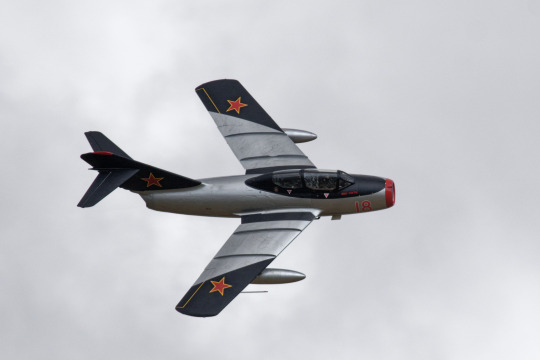
In April 1961, two events happened a few days apart :
On the 12th April, Yuri Gagarin became the first human to fly in space

Between the 17th and 19th, C.I.A. and U.S.-backed Cuban exiles attempted a military invasion of Cuba which was successfully stopped by the Cuban army.

Arnaldo Tamayo took part in the combats against the C.I.A. mercenaries who had invaded Cuba. But a week before that victory, the news of Gagarin's successful flight into the cosmos greatly inspired him. So he was happy when he was later sent in the USSR to study in the Military Aviation School.
On the 24th July 1961, Yuri Gagarin, the first man in space, arrived in La Havana for a visit after his flight. In part of his speech, Yuri Gagarin said a sentence that stuck with Arnaldo Tamayo : "The day will come when a son of the Cuban people will also travel to the cosmos."
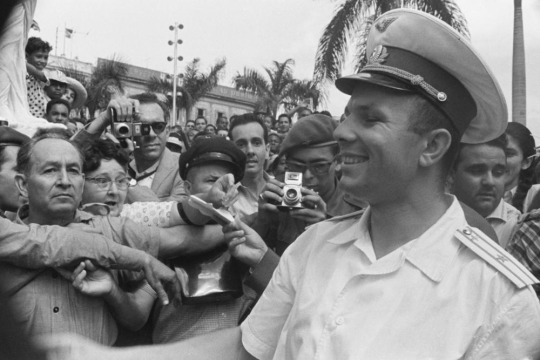



After his training in the Soviet Union (April 1961-May 1962), he came back to Cuba. In October 1962, during the Cuban missiles crisis, Tamayo carried out several reconnaissance missions (around 20) in the Cuban sky with the aim to intercept enemy aircraft. As the two powers come to an agreement, the Americans promise Moscow that they will not attack Cuba. So it is now possible for Arnaldo Tamayo to continue his studies. He applies to the Antonio Maceo Grajales Higher School of the Revolutionary Armed Forces, from which he successfully graduates in 1971. During his service in the Cuban Air Force, Arnaldo Tamayo makes countless flights and achieved the rank of first class pilot (Class I) and later become an instructor pilot. In 1975, he was chief of staff of the Santa Clara Aviation Brigade and is promoted in 1976 to lieutenant colonel.
Meanwhile, in 1966, the Intercosmos program (Интеркосмос) was created. It was a Soviet space cooperation program, carried out under the auspices of the USSR Academy of Sciences, among the countries of the socialist bloc, aimed at promoting international cooperation in space for peaceful purposes. The countries participating in this program had all adopted a socialist regime but some pro-Soviet non-aligned countries were included over the years. The program resulted in the development of 26 scientific satellites and the participation in space missions of around fifteen nationals of the co-opted countries.




In the 1970s, the Intercosmos program starts training cosmonauts to send them in space, first in 1978 with the Czechoslovak Vladimír Remek, the first neither Soviet nor American cosmonaut. Cuba then sends Arnaldo Tamayo and his colleague José Armando López Falcón to the USSR to prepare for a space flight.


The applicants had to be experienced pilots with an accident-free record and speak Russian. 600 pilots registered but the number decreased in the as the weeks went by during the tests. Tamayo Méndez and López Falcón traveled to the City of Stars, near Moscow, to train as cosmonauts.
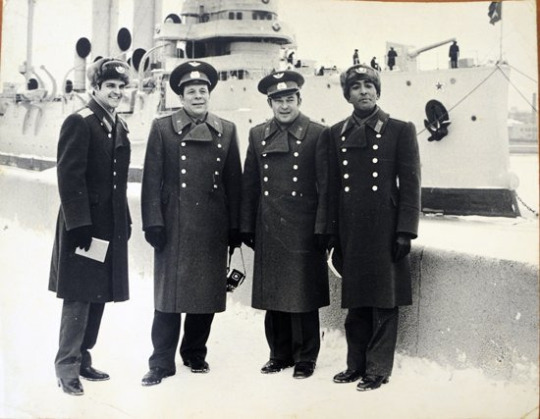


They were paired with Yuri Romanenko (Ю́рий Романе́нко) and Yevgeny Khrunov (Евге́ний Хруно́в) who both went to space once before that. Tamayo and Romanenko were chosen as the main crew while López and Khrunov were their backup crew. They started training in September 1979.



Yuri Romanenko saw Arnaldo Tamayo Méndez as jovial and has said of him : "In Tamayo, the best traits of Cubans are concentrated : the ability to work and perseverance. Plus cordiality, kindness and good humor. And believe me, they are qualities very important for cosmonauts." Arnaldo Tamayo described Yuri Romanenko as part of his family.
After a year, in September 1980, they were ready for their space flight : the "Soyuz 38" mission during which they would stay in Salyut 6, the soviet orbital space station, for several days, to carry out experiments. Finally, on the 18th September 1980, at 22:11 in Moscow and 15:11 in Cuba, Arnaldo Tamayo Méndez and Yuri Romanenko took off from the Baikonur cosmodrome (Kazakh SSR). Tamayo was traveling as a research cosmonaut while Romanenko was the commander of the spacecraft.
They were met at the Station by Leonid Popov (Леони́д Попо́в) and Valery Ryumin (Вале́рий Рю́мин), on board from April to October 1980, in light blue on the first picture. Romanenko and Tamayo's stay lasted 7 days and 20 hours, a week they used for their scientific researches.
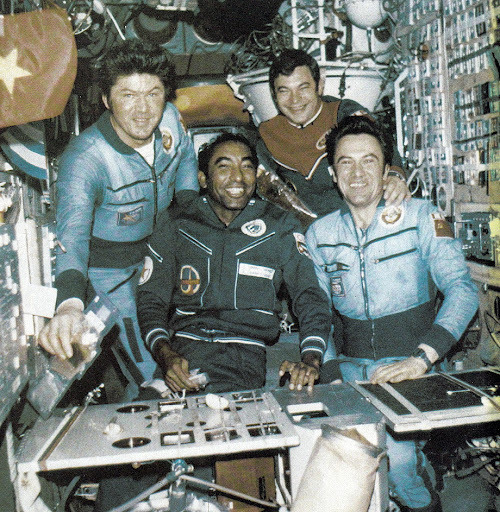
They studied different brain areas to further understand its electrical activity Another experiment was observing changes of skeletal muscle structure, as well as another on blood circulation, which sought to determine the impact weightlessness has on the human circulatory system. The other researches studied how cell division, immune system, concentrations of antibodies and other proteins and minerals were affected after prolonged exposure to a weightless environment. They also studied the growth of a crystal of sucrose in weightlessness.

They used calibrators developed by the Cuban National Institute of Sports, Physical Education and Entertainment. When the researches were completed, Soyuz 38 separated from Salyut-6 on the 25th October. The next day at 15:54, the rescue team welcomed the cosmonauts in Kazakhstan.

Arnaldo Tamayo Méndez, by being the first Latin American, first Afro-descendant and first Spanish speaker in space made history. Fidel Castro said that he "represented Cuba, Latin America, Africa and the Third World in the cosmos". Tamayo, with Romanenko was decorated by Raúl Castro with the first honorary medal of Hero of the Republic of Cuba and the Playa Girón Order. In Moscow, he received the Order of Lenin and was named Hero of the Soviet Union. His colleague had been awarded with these titles as well.
After the space flight, knowing of the sad death of Yuri Gagarin in a plane crash in 1968, Fidel prohibited the Cuban cosmonaut from flying or carrying out training flights in combat aircraft. Despite his love for flying and longing for the cosmos, Tamayo followed the orders.
Arnaldo Tamayo Méndez is now more known as a public and military leader than as a cosmonaut or a pilot. He became a general, a deputy of the National Assembly of People's Power of the republic and heads the foreign relations directorate of the Revolutionary Armed Forces of Cuba. He is still close with his colleagues, Soviet and others, especially his partner, the one he considers his "star brother" Yuri Romanenko, despite the distance and even after the fall of the U.S.S.R.. Today, Arnaldo Tamayo Méndez also heads the Cuba-Russia Friendship Association.
Arnaldo Tamayo Méndez expressed it this way: "My luck is similar to that of all the hungry people of my generation, for whom the revolution opened the paths of life. But there is a particularity, I was very lucky, they sent me to study in the Union Soviet, to a military pilot academy, and then... to the City of Stars, where cosmonauts live and study ."
Arnaldo Tamayo Méndez emphasizes that the relations between Cuba and the U.S.S.R. have deep important historical roots. The work of thousands of Soviet specialists allowed the small revolutionary island to greatly raise the level of its scientific and technical development. The participation of their engineers and agricultural specialists was a considerable contribution to the industrial development of Cuba. Thousands of Cuban students graduated from higher education centers in the USSR, receiving high-quality professional preparation, like Arnaldo Tamayo did.
Arnaldo Tamayo said that Yuri Gagarin, as a spiritual teacher, had a huge influence on him. "He was and will continue to be my idol. In the difficult moments of life, those that happen to everyone, I remember Gagarin's smile known throughout the world. And the discomfort recedes" Even if there hasn't been any other Cuban or Latin-American cosmonaut, Tamayo Méndez inspired plenty of people with his incredible trajectory of life, like Yuri Gagarin did in his time.


Look at their beautiful smiles !!
After him, several Black astronauts went to space, such as Guion Bluford (in 1983) or Mae Jemison (1992), leading the way for many more.
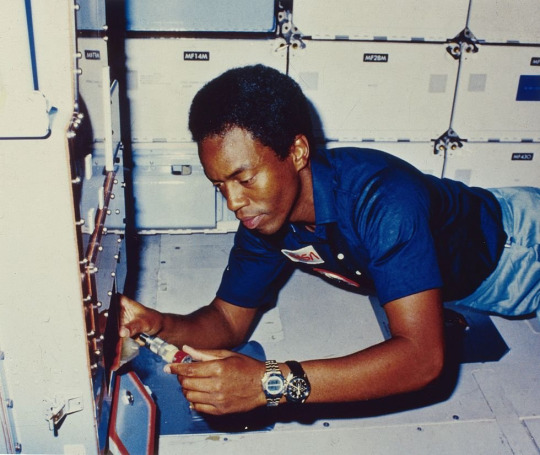
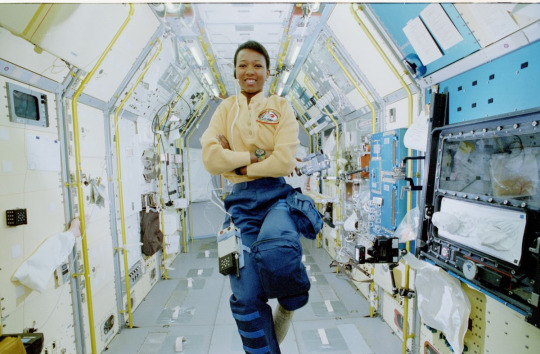
The 97th cosmonaut, Arnaldo Tamayo Méndez, has his name written in the History of World Cosmonautics as the first Cuban, first Latin American and the first Afro-descendant person who saw our planet from the Cosmos, representing his homeland and People with glory and honor.


2 notes
·
View notes
Photo

"Visit the USSR - The country of the world's first cosmonaut!"
Soviet Union
1965
575 notes
·
View notes
Text
Title: The Caves of Steel
Author: Arthur C. Clarke
Rating: 3/5 stars
After 2001 in many respects, The Caves of Steel has the same feel of "coming to a realization about how something must be after you thought you'd figured it out." The Caves of Steel is a short story -- much shorter than 2001, or even The Cold Equations, the previous Arthur C. Clarke short story collection -- so maybe I should just go ahead and say what I mean by that:
The "science fiction" in these stories is not very science fictional. Clarke's focus is much more on "speculative" extrapolations from present-day science: in particular, the extrapolations, in terms of technology, society, and cosmic scale, from biological and engineering progress in the near future. At the core of much of The Caves of Steel is the development of a new kind of "transporter," a machine that, rather than carrying anything from one location to another, will carry people from one place in the cosmos to another, via a kind of "black hole" in spacetime. A huge amount of effort, including the creation of "space stations" where the transporters stop and wait to make the round trips, goes into trying to make this idea work in practice, and in particular, to try to find the conditions under which the transporter is safe from collapse, and indeed its safe operation.
Most of these stories are about "futurism": the future, imagined, extrapolated from today, or from an imagined version of today. The first story, A Colder War, shows a post-nuclear war world in which the United States and the Soviet Union co-operate in a search for intelligent life across the universe. This co-operation takes the form of a massive "transportation" project that would transport a selected group of people from Earth to Jupiter, so that they could "live out their lives on Jupiter, in peace," without having to deal with the politics of the whole, messy Earth. The second story, On Wings of Fire, features a much more elaborate story about the future in which the U.S. and USSR still exist, but have been utterly humiliated by each other. Earth is now split into zones, each of which has been allocated to one or the other superpower. The people in Jupiter's zone are about to be transported to a new "zoo planet" that the USSR was supposed to have won from the USA in the Cold War. However, the zoo planet, as it turns out, was a U.S. zoo, and the people are actually zoo-keepers, sent there to make sure the zoo does not break out and kill them. A group of scientists, who knew of this plan, are trying to break the zoo out of a sense of guilt; this has no effect, and when the zoo breaks out and tries to kill them, they have no choice but to fight back. "On Wings of Fire" has the feel of a "what if...?" story in which the "what if" is, in fact, what the future would look like had history gone differently (the "future" being represented by the USSR). It also has the feel of a horror story, in that it's about how a story of the same kind can play out not in a speculative future, but in the present. The Longest Voyage features the setting of a future in which Earth has been "colonized" by a post-scarcity society that uses genetic engineering to create all the necessary and useful elements of its technology from scratch, without the need to mine for them from other sources. This has led to some "artificial scarcity," in the sense of needing to import elements that exist in large amounts on other worlds. The story involves a journey to one such world, inhabited by an isolated alien society, the "Porrims," who have the "technology" of "space ships" but no interest in exploiting the technology's full capabilities.
The last story is about a "scavenger" civilization, one that takes advantage of the "gravitational anomalies" in space to "scavenge" from other spacefaring civilizations. They build "transport engines" from the stuff they bring back, with no interest in creating technology for its own sake -- just in taking the technology of other, more developed, civilizations and "recycling" it, turning it into "scavenger technology," which then becomes the new technology of the "scavenger civilization." One of these technologies is the "scavenger space craft," which consists of a vast circular "tunnel" encircled by a transparent shell, surrounded by a mass of fuel (an enormous quantity of very-low-grade fuel), with a sort of "transporter" built in the center that can make the fuel mass move from the fuel reserves to the fuel reservoirs around the inside of the tunnel. I guess the story is basically about how the "scavenger civilization" would have ended up if, from the get-go, it had been interested in producing "new" rather than just "scavenger technology."
2 notes
·
View notes
Text
youtube
Is the US Getting Ready for a PEARL HARBOR in SPACE? |
VisualPolitik EN
Space, the cosmos, the universe, is an idea, a concept that has been haunting the human mind for literally thousands and thousands of years.
Way back in the 2nd century, in his work “A True Story” writer Luciano de Samosata toyed with the idea of reaching the stars. And he wasn’t the only one. Since then, there have been many others, like Cyrano de Bergerac, Daniel Defoe, and of course, Jules Verne! They continued to fantasize about flying to distant alien worlds.
However, over the last few decades, another facet of space has been gradually creating a new competition: the war of the galaxies, the use of space as a new battleground.
The idea was basically put into action by Ronald Reagan during the last stage of the Cold War. However, although it fell into limbo for a while, now this idea is resurfacing again. In fact, on 20th/12/2019, the US President, Donald Trump, signed the order establishing the creation of the new US Space Forces. A new division of the US Army that joins the Navy, the Army, the Air Force & the Marines.
Now, what exactly are these space forces?
Why has Donald Trump decided to put them into action?
How have other powers such as China or Russia reacted to this decision? When and how did the idea of Star Wars arise?
In this video, we answer all these questions and we also bring you closer to 1 of the most fiercely contested competitions of all times: the Space Race b/w the US & the USSR.
0 notes
Text
Beyond the Horizon: Unveiling the Mysteries of Space Exploration
For millennia, humanity has gazed upwards, Unveiling the Mysteries of Space Exploration captivated via the twinkling tapestry of stars. Space exploration, our undertaking to project beyond Earth and get to the bottom of the cosmic mysteries, is a testament to our insatiable curiosity and yearning for knowledge. From the first tentative steps on the moon to the rovers traversing Martian landscapes, space exploration has revolutionized our understanding of the universe and our vicinity within it.

A Journey Through Time: A History of Space Exploration
Our fascination with space can be traced again to historic civilizations. Early astronomers meticulously charted the motion of celestial bodies, laying the foundation for future exploration. The invention of the telescope inside the 17th century revolutionized our view of the cosmos, revealing distant planets, moons, and galaxies.
The sunrise of the space age arrived inside the twentieth century. In 1957, the Soviet Union launched Sputnik 1, the primary artificial satellite tv for pc to orbit Earth. This marked a pivotal second, igniting the Space Race among america and USSR. The following years noticed a flurry of groundbreaking achievements: Yuri Gagarin have become the primary human in area in 1961, and Neil Armstrong took "one small step for guy, one giant bounce for mankind" at the moon in 1969.
The Present: Unveiling the Universe, One Mission at a Time
Today, area exploration is a collaborative effort, with numerous nations and personal groups contributing their knowledge. Several area agencies, such as NASA, ESA (European Space Agency), and JAXA (Japan Aerospace Exploration Agency), are actively engaged in diverse missions.
Robots Leading the Way:
Uncrewed robot missions had been instrumental in exploring the full-size expanse of area. Rovers like Curiosity and Perseverance are presently exploring the surface of Mars, looking for signs and symptoms of past or gift lifestyles. Space probes have ventured similarly, reading the outer reaches of our solar system and past. Cassini's exploration of Saturn and its moons, and New Horizons' flyby of Pluto, have unveiled those celestial bodies in terrific detail.
Looking to the Stars: The Future of Space Exploration
Space exploration holds significant capacity for the destiny. Here are a few interesting possibilities on the horizon:
The Search for Extraterrestrial Life: One of the maximum profound questions humanity ponders is "Are we on my own?" Missions like the James Webb Space Telescope purpose to discover potentially liveable exoplanets, planets outdoor our sun gadget that might support life.
Colonizing Space: Establishing a permanent human presence on different celestial bodies, like Mars or the Moon, is an ambitious lengthy-term intention. This could allow us to study those environments in extra element and potentially stable humanity's future past a delicate Earth.
Resource Acquisition: Asteroids and comets may additionally maintain precious assets like water ice and valuable metals. Space exploration paves the way for making use of these resources within the destiny.
Technological Advancements: Every space venture pushes the boundaries of era. The improvements advanced for space exploration have severa programs again on Earth, from scientific improvements to conversation technology.
The Benefits of Reaching for the Stars
Space exploration isn't just about planting flags or accomplishing "firsts." It has tangible advantages that effect our lives on Earth:
Improved Weather : Satellites orbiting Earth provide vital facts for climate prediction, permitting us to prepare for natural disasters and make informed choices approximately agriculture.
Global Communication: Satellites play a essential position in our interconnected world, permitting verbal exchange throughout giant distances and facilitating technology like GPS.
Environmental Monitoring : Space exploration is an undeniably difficult endeavor. The price and complexity of missions are tremendous, and the enormous distances involved gift logistical hurdles. Additionally, area journey contains inherent risks, as evidenced with the aid of the tragic lack of the Space Shuttle Columbia in 2003.
Challenges and the Road Ahead
However, the ability rewards a ways outweigh the challenges. Beyond the Horizon As we keep to explore area, we advantage a deeper understanding of our place within the cosmos. This pursuit fosters international collaboration, evokes innovation, and ignites the imaginations of future generations.
Space-primarily based observatories track environmental adjustments on Earth, assisting us recognize climate change and broaden sustainable practices.
1 note
·
View note
Text
Demigod's of Death
We touched on this a little in the “Lysenko, Famine’s High Priest” blog post, but lets get to the meat of what he and many like him really had going on. How do we even begin to comprehend the size of his ego, to try and force biology to fit to his opinion of what it should be; or Stalin or Mao’s supporters belief that they worked towards utopia. Maybe these “cosmos-heads” could be somewhat forgiven if there was any fruitfulness from their attempts, but they weren’t even close! There’s a term that beckons from the soviet era to refer to these unhinged academics, “The Intelligencia.” What made the intelligencia so dangerous and arrogant was their echo-chambers and adoration. Echo-chambers should need no introduction in this modern age, with social media creating hubs of like-minded individuals, from gardening to politics. When they truly become warped is when they are founded on a sacred, or irreproachable premise. Life is almost never black or white, everything has its caveat, its instance of fallibility, but this impedes conversation and the pursuit of transcendence, so we often ignore them. For the intelligencia of Soviet collegiates, the irrefutable premise was Marxism. This was made even worse by the guarantee that only vocal Marxist students had a chance of being selected for state jobs (Keep in mind that all academic jobs were administered by the state). So, the USSR really thought it had a jewel of pure truth worthy of worship figured out. Now lets imagine we’re one of these students that really “drank the Kool-Aid.” We’re tasked with plotting the way forward in every walk of life, consistent with the “holy dogma” of the party. Uplifting the downtrodden and making life better by reshaping the old ways to fit this system of casteless utopia. Thoughts and concerns of personal elitism were tabled for when the pure vision manifested (in theory). In no slight to the very definition, they were the creators of heaven. Imbued with self-righteous certainty that validated every warped theory crafting conversation and honest solution-seeking conference they held. What’s more, they were so valuable to the cause, they were shown ultimate deference by the rabble they guided, lest the secret police mark them a dissenter of the doctrine! How could one not view themselves as a god when made socially irreproachable? This should be ringing some bells of what is currently happening on our own western campuses. Intelligent, theory-inundated students that tout a doctrine so apparently righteous, that it stupefies them to be met with contention. A sign that maybe a thousand hours of study would’ve been better spent with a hundred and planting some tomatoes with a stranger. We should always be wary of people who shut down when tested in their beliefs. How arrogant and self-righteous to assume that possible fault found within their beliefs is out of the question. To view another person as so ignorant that we can only educate them, or silence them. We have to be careful of how we elevate others, especially our nerdy and naïve specialists. We need talented problem solvers, not deranged demigods.
0 notes